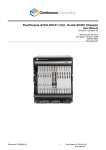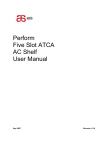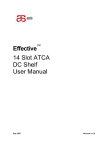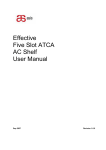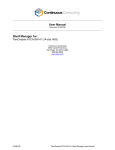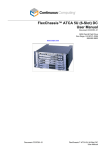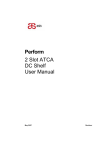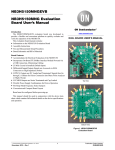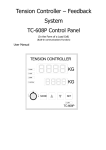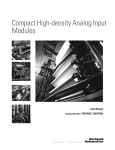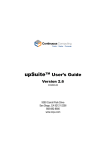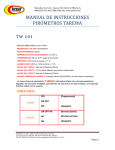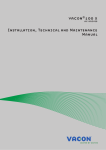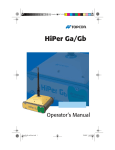Download FlexChassis ATCA-SH61
Transcript
FlexChassis ATCA-SH61
User Manual
Document: CC09456-01
9450 Carroll Park Drive
San Diego, CA 92121-2256
858-882-8800
www.ccpu.com
Document CC09456-01
FlexChassis ATCA-SH61
User Manual
© 2001-2010 Continuous Computing Corporation. All rights reserved.
The information contained in this document is provided “as is” without any express representations of warranties.
In addition, Continuous Computing Corporation disclaims all implied representations and warranties, including any
warranty of merchantability, fitness for a particular purpose, or non-infringement of third party intellectual property
rights.
This document contains proprietary information of Continuous Computing Corporation or under license from third
parties. No part of this document may be reproduced in any form or by any means or transferred to any third party
without the prior written consent of Continuous Computing Corporation.
Continuous Computing, the Continuous Computing logo, Flex21, upSuite, upDisk, and upBeat are trademarks or
registered trademarks of the Continuous Computing Corporation or its affiliates. All other product names
mentioned herein are trademarks or registered trademarks of their respective owners. The products described in
this document maybe protected by U.S. patents, foreign patents, or pending applications. No part of this
publication may be reproduced, stored in a retrieval system or transmitted, in any form or by any means,
photocopying, recording or otherwise, without prior written consent of Continuous Computing Corporation. No
patent liability is assumed with respect to the use of the information contained herein. While every precaution has
been taken in the preparation of this publication, Continuous Computing Corporation assumes no responsibility for
errors or omissions. This publication and features described herein are subject to change without notice.
The information contained in this document is not designed or intended for use in human life support systems,
on-line control of aircraft, aircraft navigation or aircraft communications; or in the design, construction, operation or
maintenance of any nuclear facility. Continuous Computing Corporation disclaims any express or implied warranty
of fitness for such uses.
Document CC09456-01
FlexChassis ATCA-SH61
User Manual
Table of Contents
Table of Figures .................................................................................................................................................... 5
Safety Instructions ................................................................................................................................................ 6
About this Document ............................................................................................................................................ 8
1 Introduction ........................................................................................................................................................ 9
1.1 FlexChassis ATCA-SH61.............................................................................................................................. 9
1.2 Part Number ................................................................................................................................................. 9
2 Understanding the Shelf Components ........................................................................................................... 10
2.1 Platform Components ................................................................................................................................. 10
2.1.1 Shelf and Boards ................................................................................................................................. 10
2.1.2 Card Cage ........................................................................................................................................... 13
2.1.3 Backplane ............................................................................................................................................ 14
2.1.4 Module Slot Identification..................................................................................................................... 17
2.1.5 AC Power Supply ................................................................................................................................ 17
2.1.6 PEM .................................................................................................................................................... 18
2.1.7 Fan Trays ............................................................................................................................................ 20
2.1.8 Air Filter Tray ....................................................................................................................................... 21
2.1.9 Blank Panels with/without air baffles .................................................................................................... 21
2.1.10 Shelf ID Board ................................................................................................................................... 22
2.1.11 Holder for Cable Management (Optional) .......................................................................................... 23
2.1.12 Shelf Manager Board ......................................................................................................................... 23
2.2 Shelf Cooling .............................................................................................................................................. 24
2.2.1 Overview ............................................................................................................................................. 24
2.2.2 Fan Tray Design .................................................................................................................................. 24
2.2.3 Performance ........................................................................................................................................ 24
2.2.4 Fan Speed ........................................................................................................................................... 25
3 Installing the Shelf ........................................................................................................................................... 26
3.1 Tools Required ........................................................................................................................................... 26
3.2 Site Planning .............................................................................................................................................. 26
3.3 Checking Package Contents ....................................................................................................................... 27
3.4 Installation Steps ........................................................................................................................................ 27
3.5 Rack Mounting ............................................................................................................................................ 27
3.6 Shelf Grounding .......................................................................................................................................... 27
3.7 Installer Grounding ..................................................................................................................................... 28
3.8 Shelf Power-Up........................................................................................................................................... 28
3.9 Shelf Third-party Application Card Insertion................................................................................................ 29
3.10 Shelf Management Card insertion............................................................................................................. 29
4 Maintenance And Troubleshooting ................................................................................................................ 30
4.1 Performing Periodic Maintenance ............................................................................................................... 30
4.1.1 Fan Tray Visual Inspection .................................................................................................................. 30
4.1.2 Air Filter Cleaning and Replacement ................................................................................................... 30
4.2 Handling Electromagnetic Interference ....................................................................................................... 31
4.3 Extracting/Inserting Modules ....................................................................................................................... 31
4.3.1 Third Party Board Insertion .................................................................................................................. 31
4.3.2 Third Party Board Extraction................................................................................................................ 31
4.3.3 Shelf Manager Board Insertion ............................................................................................................ 32
4.3.4 Shelf Manager Board Extraction .......................................................................................................... 32
4.3.5 Power Supply Insertion ........................................................................................................................ 32
4.3.6 Power Supply Extraction...................................................................................................................... 32
4.3.7 PEM Insertion ...................................................................................................................................... 32
4.3.8 PEM Extraction .................................................................................................................................... 33
4.3.9 Fan Tray Replacement ........................................................................................................................ 33
4.3.10 E²PROM Replacement ...................................................................................................................... 33
4.4 Handling Alarms ......................................................................................................................................... 34
4.4.1 Visual Alarms....................................................................................................................................... 34
4.4.2 Software Alarms .................................................................................................................................. 35
4.5 Hot-Swapping FRUs ................................................................................................................................... 35
4.6 Resetting the System .................................................................................................................................. 36
4.7 Troubleshooting .......................................................................................................................................... 36
5 System Specifications ..................................................................................................................................... 37
Document CC09456-01
FlexChassis ATCA-SH61
User Manual
5.1 Certification ................................................................................................................................................. 37
5.2 Technical Data ............................................................................................................................................ 38
5.3 Acronyms Used in this Manual.................................................................................................................... 39
Document CC09456-01
FlexChassis ATCA-SH61
User Manual
Table of Figures
I.D.
Figure
Page
1
Shelf Block Diagram
11
2
Shelf Front view
11
3
Shelf Rear View
12
4
Shelf Chassis with Cable Holders
12
5
Shelf Component Positioning
13
6
Base interface channel
15
7
Synchronization clock and update channel pin assignments
15
8
Backplane Layout
16
9
Slot Allocations
17
10
Shelf Addressing
17
11
ATCA 1500W AC Power Supply
18
12
ATCA DC PEM
19
13
Distribution of Power on Shelf
20
14
Fan Tray
21
15
Air Filter Tray
21
16
Blank Board Panel and Blank RTM Panel
22
17
Shelf ID Board with two E²PROMs (rear cover removed)
23
18
Fan and Air Filter Trays
24
19
Rear grounding screws
28
20
Front ESD Socket
28
21
Shelf Air filter Extraction and Power supply air filter extraction
31
22
Shelf fan tray extraction
33
23
General LEDs
34
24
Telco Alarm LEDs
34
25
LEDs status when Shelf Manager boot-up completely
35
26
Application-defined LEDs
35
Document CC09456-01
FlexChassis ATCA-SH61
User Manual
Safety Instructions
General Safety Practices
Before handling the board, read the instructions and safety guidelines on the following pages to prevent
damage to the product and to ensure your own personal safety.
o Always use caution when handling/operating the board. Only qualified, experienced,
authorized electronics service personnel should access the interior of the equipment. The
power supplies produce high voltages and energy hazards, which can cause bodily harm.
o Use extreme caution when installing or removing components. Refer to the installation
instructions in this document for precautions and procedures. If you have any questions,
please contact Technical Support.
o Always follow the procedural instructions for component removal and replacement in
sequence.
Power
Beware Electrical shock hazard before any attempt to service the device be sure that the device is
electrically isolated!!!
High voltages are present inside the chassis when the unit's power is plugged into an electrical outlet. Turn off
system power, turn off the power supply, and then disconnect the power cord from its source before removing
the chassis cover.
Turning off the system power switch does not remove power to components.
Make sure the work environment is grounded, and use a grounding wrist strap when handling the product.
ESD Safety Practices
Many components described in this document can be damaged by electrostatic discharge (ESD). Follow the
precautions described here and before specific procedures in the document to protect static-sensitive
components from ESD-related damage.
Static electricity can harm system boards. Perform service at an ESD workstation and follow proper ESD
procedure to reduce the risk of damage to components. It is encouraged to follow proper ESD procedure, which
can include wrist straps and smocks, when servicing equipment.
Take the following steps to prevent damage from electrostatic discharge (ESD):
o
When unpacking a static-sensitive component from its shipping carton, do not remove the
component’s antistatic packing material until you are ready to install the component in the
system. Just before unwrapping the antistatic packaging, be sure you are at an ESD
workstation or grounded. This will discharge any static electricity that may have built up in
your body.
o
When transporting a sensitive component, first place it in an antistatic container or
packaging.
o
Handle all sensitive components at an ESD workstation. If possible, use antistatic floor
Document CC09456-01
FlexChassis ATCA-SH61
User Manual
pads and workbench pads.
o
Handle components and boards with care. Don’t touch the components or contacts on a
board. Hold a board by its edges or by its metal mounting bracket.
o
Do not handle or store system boards near strong electrostatic, electromagnetic,
magnetic, or radioactive fields.
Document CC09456-01
FlexChassis ATCA-SH61
User Manual
About this Document
This document provides technical information for the FlexChassis ATCA-SH61.
It is intended for technical staff tasked with installing, setting up and configuring the system, and providing
troubleshooting assistance and servicing.
Related Documents
For information on the Shelf Manager, see the Continuous Computing Shelf Manager Carrier Board user
manual.
Instructions relating to software installation and documentation for application software development for this
platform are available in the Shelf Manager External Interface Reference Manual.
Information about PICMG (PCI Industrial Computer Manufacturers Group) and the ATCA standard may be
accessed on the PICMG Web site at http://www.picmg.com.
Style Conventions
Verdana
Regular text.
Arial Bold
Commands, keys and other parts of the user interface.
Arial Italics
Names of classes, methods, arguments, exceptions, properties, etc.
Also used for special terms, the first time they appear.
Monospace
Text displayed on the LCD or on a computer attached to the product.
Notes, which offer an additional explanation or a hint on how to overcome a
common problem.
Warnings, which indicate potential safety hazards regarding product operation
or maintenance to operator or service personnel.
Document CC09456-01
FlexChassis ATCA-SH61
User Manual
1 Introduction
This chapter includes a summary of the FlexChassis ATCA-SH61. For acronyms used in this document see
Section 5.3.
1.1 FlexChassis ATCA-SH61
The FlexChassis ATCA-SH61 offers the reliability and availability of the Telco-grade standards in a cost-effective
package, where maximum possible performance (backplane interconnect bandwidth, power levels and thermal
capabilities) is provided in a low-cost shelf.
The FlexChassis ATCA-SH61 has been developed based on the accumulated knowledge and experience in the
implementation of the ATCA standard since its inception in 2001, while incorporating the latest technologies
available. It incorporates the latest technologies available to reduce its price while maintaining performance and
reliability.
The system offers optional redundancy for power input and management functions.
The system can be used by developers (reduced time-to-market) as well as for deployment. It offers optional
redundancy for power input and management functions (see Section 2.1.5). All shelf assemblies are designed
using Field-Replaceable Units (FRUs), thus enabling easy and fast field maintenance with minimum or no
downtime, availability of 99.999%.
In addition, a cable-holder frame can be fitted to both side-mounting flanges of the shelf (see Section 2.1.10).
The FlexChassis ATCA-SH61 is designed to comply with FCC and CE certification, and with UL, NEBS
Level-3 and ETSI.
The FlexChassis SH-61 fully complies to AdvancedTCA, PICMG 3.0 R2.0, and IPMI v 1.5.
See Section 5.2 for detailed system specifications.
1.2 Part Number
Part Number
Module
5-02977
FlexChassis ATCA-SH61 19", 6U, 6-slot shelf 40G; designed to
accommodate (but does not include) 3x AC PSUs or 2x rear PEMs
Document CC09456-01
FlexChassis ATCA-SH61
User Manual
2 Understanding the Shelf Components
This chapter summarizes the functional features of the FlexChassis ATCA-SH61, and describes in further
detail each of the components as well as the shelf system cooling mechanism.
The system was designed to withstand extreme conditions (to meet rigid Telco requirements). It is designed to
incorporate Field-Replaceable Units (FRUs), and is fully field-serviceable.
2.1 Platform Components
A typical platform consists of the following key components:
o
19-inch rack mount shelf — Base hardware element of the platform, which holds all the
components together.
o
Card cage — Portion of the shelf that holds the modules that are plugged into the backplane.
Mechanically compliant with all aspects of PIMG 3.0.
o
Backplane — Supports one to six third-party ATCA-compliant front boards, and the
complementary rear transition module (RTM). The backplane provides dual star Fabric
interface, and direct mating to the Power Supplies and to the redundant Shelf Manager
Boards.
o
Power Supply (PS) - Up to three Redundant, field replaceable, 90 VAC to 264 VAC, power
supplies.
o
PEM (Power Entry Module) — Dual redundant and hot swappable Power Entry Modules.
o
Fan tray — Dual Redundant push–pull fan trays. Hot-swappable, provides side to side cooling,
and is designed to provide full redundancy cooling to components on the front and rear of the
shelf.
o
Air filter tray — Keeps the airflow free of dust and particles.
o
Blank Panels — For air flow management.
o
Shelf ID Board (E²prom) – Contains the shelf identification information.
o
Cable management - Holders for Front cable management.
2.1.1 Shelf and Boards
Figure 1 shows the block diagram of the shelf and figures 2 and 3 show front and rear views of the
shelf with key components highlighted.
Document CC09456-01
FlexChassis ATCA-SH61
User Manual
Fan Tray
RMCP, SNMP, CLI, Web
Shelf Manager
I2C bus
IPMB
Power
I2C bus
Shelf FRU
EEPROM
Shelf Manager
I2C bus
IPMB
Power
I2C bus
Shelf FRU
EEPROM
USB or Eth
RMCP, SNMP, CLI, Web
RTM1
Hub A
RTM 2
RTM 5
Slot 6
Clk, Update Channel
Hub B
RTM 3
RTM 4
Power
Fabric channel
Base channel
Slot 3
IPMB
Slot 4
Power
Slot 5
Slot 6
B
A
C
K
P
L
A
N
E
I2C bus
Power
PEM A
I2C bus
Power
PEM B
VDC
VDC
I2C bus
Power
Power Supply A
I2C bus
Power
Fan Tray
Air Filter
Power Supply B
Power
Presence Signal
Figure 1 – Shelf Block Diagram
Figure 2 – Shelf Front View
Document CC09456-01
FlexChassis ATCA-SH61
User Manual
VAC
VAC
Figure 3 – Shelf Rear View
Figure 4 illustrates the use of cable holders:
Figure 4 – Shelf Chassis with Cable Holders
Document CC09456-01
FlexChassis ATCA-SH61
User Manual
Figure 5 - Shelf Component Positioning
In order to increase FlexChassis ATCA-SH61 reliability, and to simplify the shelf’s format, most of the shelf logic
is located in a one location, the shelf manager. Most of the other boards and FRU’s are passive.
Only the backplane is a fixed board. Remaining boards are removable:
Fixed Board
o
Backplane
Removable Boards
o
Shelf Manager Board boards (see the Shelf Manager Carrier Board User Manual).
o
Shelf ID board: this board hosts two E²PROMs that contain data about the shelf – such as serial
number and manufacturer – and about the board’s setup – such as shelf thermal budget and slot
population.
o
Power Supplies
o
Power Entry Modules
o
Fan Trays
o
Air Filter
2.1.2 Card Cage
The shelf’s card cage is composed of:
o
The backplane
o
Right and left guide rails to hold the modules that plug into the backplane.
The card cage supports six 8U front boards, and six 8U RTMs.
The guide rails in the card cage incorporate electrostatic discharge (ESD) clips.
Document CC09456-01
FlexChassis ATCA-SH61
User Manual
2.1.3 Backplane
Features
The ATCA PICMG 3.0-compliant backplane provides interconnectivity between the FRU’s and shelf’s front
blade connectivity. It conforms to the PICMG 3.0 R2.0 AdvancedTCA Base Specification.
Backplane features include:
o
PCB is made from Nelco material
o
Base interface is wired as dual star
o
The Base interface grid consists of four differential pairs per channel (supporting 10Gbps/each) and in
total contains six Base channels for a total of 20 possible signal pairs per board/slot
o
3x replicated mesh Fabric interface with slots numbered from bottom to top
Continuous Computing is using dual star toplogy at software level
o
Each connector on the Fabric interface supports up to six channels available for board-to-board
connectivity
o
Bussed IPMI
o
Hub/node configuration; logical are slots 1 & 2
o
Update channel between slots 1&2 and 3&4 and 5&6
o
Connection capacity for up to six third-party ATCA-compliant front boards, as well as to the
redundant Shelf Manager Board and redundant Power Supply units.
o
Full compliance with AdvancedTCA™ electrical and mechanical specifications
o
Interconnect for system power for six slots.
o
Base interface Channel 1 of Logical Slot 1 is routed to the left dedicated Shelf Manager slot on the
ATCA backplane
o
Base interface Channel 1 of Logical Slot 2 is routed to the right dedicated Shelf Manager slot on the
ATCA backplane.
There are no active components on the backplane, and no removable or serviceable parts on the backplane
board.
The backplane has two functionally-distinct parts: right and center left:
o
Right backplane (consists of Zone 1 connectors) – Supports dual-power connections, which
means the power connections from the PSUs/PEMs are independently supplied to each module
plugged into the backplane. The modules also include fuses that protect the backplane power
connections from an electrical short on a module.
o
Center left backplane (consists of Zone 2 connectors) – Supports connectivity for the Base,
Fabric, and update-channel interface. This portion supports the dual star connectivity for both
the Base and the Fabric interfaces. The update channels are routed to adjacent slots. Slot 1
connects to Slot 2, Slot 3 connects to Slot 4 and Slot 5 connects to Slot 6.
Update-Channel Connections
The update channels are backplane connections between pairs of modules that operate on a redundant basis.
Application software can use the update channel for redundancy interlock, or to provide a direct connection that
bypasses the (indirect) fabric interface.
Document CC09456-01
FlexChassis ATCA-SH61
User Manual
If you configure a pair of modules to use the update channel for redundancy support, you must insert the two
modules into slots linked by an update channel.
Figure 7 shows the update channel connections.
Each update channel consists of 10 differential-pair connections. If an update channel connects two modules that
are not identical, the Shelf Manager disables the update channel between them.
Base interface
The Base interface comprised of a single raw of signal pins for a total of four signal pairs per Base interface. In
total the Base interface contains 6 Base channels for a total of 20 possible signal pairs per board/slot. A Base
channel can be used to support a 10/100/1000BASE-T Port comprised of four signal pairs.
Figure 6 - Base interface channel
Fabric interface
The Fabric Interface allocates signal pairs differently than the Base Interface. A Fabric Channel is comprised of
two rows of signal pairs for a total of eight signal pairs per Channel. Thus, each connector supports up to six
channels available for Board to Board connectivity. A Channel may also be viewed as being comprised of four
2-pair Ports.
Synchronization Clock Interface
The backplane supports a set of synchronization clock buses that can exchange synchronization timing
information. This synchronization can be used for system-wide and intersystem synchronization purposes,
which are important in some applications, such as those involving synchronous time division multiplex
(TDM).
Row
Interface
Px20 Connector Pairs
#
ab
cd
ef
gh
1
Clks
CLK1A+
CLK1A-
CLK1B+
CLK1B-
CLK2A+
CLK2A-
CLK2B+
CLK2B-
2
Update
Tx4(UP)+
Tx4(UP)-
Rx4(UP)+
Rx4(UP)-
CLK3A+
CLK3A-
CLK3B+
CLK3B-
Tx2(UP)+
Tx2(UP)-
Rx2(UP)+
Rx2(UP)-
Tx3(UP)+
Tx3(UP)-
Rx3(UP)+
Rx3(UP)-
Tx0(UP)+
Tx0(UP)-
Rx0(UP)+
Rx0(UP)-
Tx1(UP)+
Tx1(UP)-
Rx1(UP)+
Rx1(UP)-
3
channel &
Clks
4
The update channels are routed to adjacent slots. Slot 1 connects to Slot 2, Slot 3 connects to Slot 4 and Slot 5
connects to Slot 6.
Document CC09456-01
FlexChassis ATCA-SH61
User Manual
Figure 7 – Synchronization clock and update channel pin assignments
Figure 8 - Backplane Layout
Document CC09456-01
FlexChassis ATCA-SH61
User Manual
2.1.4 Module Slot Identification
The shelf is compliant with PICMG 3.0 R2.0, and accepts modules compliant with this standard.
Figure 9 illustrates the locations of the module slot allocations when viewed from the front. The physical and
the logical slot allocations are the same for this shelf: the slots are numbered 1 to 6 from bottom to top.
Figure 9 – Slot Allocations
The following table shows the hardware addresses in relation to the slot numbers and slot addresses. Slots are
shown in the same order as they appear in the shelf: slot 2 above slot 1.
Slot
Hardware Address
Hardware Address
Number
(8 bit format)
(7 bit format)
6
8Ch
46h
5
8Ah
45h
4
88h
44h
3
86h
43h
2
84h
42h
1
82h
41h
Figure 10 - Shelf Addressing
2.1.5 AC Power Supply
The field replaceable and hot swappable, 90VAC to 264VAC, power supplies provide power to the shelf.
The FlexChassis ATCA-SH61 is equipped with AC power inlets which are located in the rear for redundancy.
Each power supply is capable of supplying 1500W. Two power supplies are required to power a
fully-occupied shelf. The use of a third power supply is for cases where redundancy and/or additional power
Document CC09456-01
FlexChassis ATCA-SH61
User Manual
are needed.
The three power supplies are located in the lower part of the shelf. power supply has its own front-back
independent cooling. In order to comply with NEBS GR63 Core, the power supplies have separate removable
air filters.
The air filters should be cleaned or replaced every three to six months. They can be cleaned with slightly
compressed air, vacuumed, and/or rinsed with clean water. If a degreaser is required, use only a mild
detergent, such as, dishwashing liquid. Avoid using harsh solvents or cleaning agents. Even though this type
of filter may be cleaned, replacement is recommended every two to three years to ensure durability and
eliminate residual dust build-up and subsequent air flow resistance.
The AC inlet connectors are located on the rear of the shelf.
Please use a power cord with the following rating:
Rated for 250 volt, 15/10 amp, 2 poles, 3 wire. Connector can be terminated to 14 thru 16 AWG (gauge) cord
only. UL, CSA, VDE approved.
Female Connector IEC 60320 C13 on one end and your standard domestic AC power plug that fit's your wall
AC sockets on the other end.
Figure 11 - ATCA 1500W AC Power Supply
Note – Do not use power supplies and PEM simultaneously. In case of using an AC source, plug the power
supplies in and remove the PEMs. In case of DC source, plug in the PEMs and remove the power supplies.
Grounding Requirements and Power Input
When connecting ground and power cables to the shelf, follow instructions in the beginning of this
document.
2.1.6 PEM
The SH61 is equipped with connectors for two redundant hot swappable and field replaceable -48VDC PEMs.
A single PEM is capable of supplying 300W of power to each blade slot, or rather enough power for the entire
shelf. Both PEMs are located in the lower-back of the shelf, fitting directly into to the backplane. The DC
connectors (connected internally) are located on the rear of the chassis. There is no limitation of connector
combination. Each PEM is equipped with a 50Amp circuit breaker.
For DC connectors, the minimum nominal diameter of terminal block need be more than 6.0mm.
The thread size of the DC connection bolts/lugs is M4.
Document CC09456-01
FlexChassis ATCA-SH61
User Manual
PEM power input is divided to two power feeds, maximum current (25A) per power feed. Use four AWG8 Power
connection cables, Conductor Diameter 3.3mm, suitable for 25A per power feed (single M4 screw). Use AWG10
for Shelf Ground Connection.
-48VDC
Return
Figure 12 - ATCA DC PEM
Note – Do not use power supplies and PEM simultaneously. In case of using an AC source, plug the power
supplies in and remove the PEMs. In case of DC source, plug in the PEMs and remove the power supplies.
Document CC09456-01
FlexChassis ATCA-SH61
User Manual
SLOT 6
SLOT 5
SLOT 4
SLOT 3
SLOT 2
SLOT 1
Figure 13 - Distribution of Power on Shelf
Grounding Requirements and Power Input
2.1.7 Fan Trays
SH61 ventilation is achieved using a push / pull scheme. Each fan tray contains six 92mm x 92mm fans for front
card cooling and four 40mm x 40mm fans for RTM cooling. (see Figure 14). The cooling power of the fan tray
can dissipate the heat generated by up to six front boards and complementary RTMs.
A total bulk airflow of 548cfm is supported.
Six of the fans are dedicated to cooling the front side of the shelf, while four are cooling the rear side Boards.
The two fan trays are designed full redundancy to meet the cooling requirements of a full shelf in the most
demanding situations.
In case of single fan failure, the other fan tray in addition to the remaining fans in the same tray will provide the
required cooling to dissipate the heat generated by the occupied slots. If a failure occurs, it is recommended to
replace a fan tray as soon as possible.
Both fan trays are factory-mounted in the FlexChassis ATCA-SH61. They are easily replaceable,
and can be replaced while the shelf is operating.
For more on shelf cooling, see Section 2.2.
Document CC09456-01
FlexChassis ATCA-SH61
User Manual
Figure 14 – Fan Tray
2.1.8 Air Filter Tray
A NEBS-GR63-compatible air filter comes installed on the FlexChassis ATCA-SH61. The filter is field-serviceable,
and can be extracted for periodic field maintenance or for field replacement.
The filter is easily accessible from front right side of the card cage.
For instructions on air-filter maintenance, see Section 4.1.2.
Figure 15 – Air filter tray
2.1.9 Blank Panels with/without air baffles
Compliance with ATCA's temperature specifications requires a steady air flow in the shelf. To insure a steady air
Document CC09456-01
FlexChassis ATCA-SH61
User Manual
flow, either the FlexChassis ATCA-SH61 must be fully populated, or a blank panel must be equipped to fill every
empty slot.
The "blank panel" is designed to emulate the air flow restriction in a standard card, thus ensuring the required
conditions for proper cooling.
Three types of airflow-management panels are available for the empty slots on the shelf.
These include panels specifically designed for:
o
Blank front module panels, with/without air baffle;
o
Blank RTM panels;
o
An empty shelf-manager panel slot.
Figure 16 - Blank Board Panel and Blank RTM Panel
2.1.10 Shelf ID Board
A shelf ID board containing two redundant field replaceable E²PROM chips is housed in the rear of the
FlexChassis ATCA-SH61.
The E²PROMs store product and manufacturer information such as shelf serial number, part number, backplane
routing assignment, and shelf heat budget.
When the Shelf Manager board boots up, it compares the information stored in the two E²PROMs:
If E²PROM data coincides, it is loaded and saved in the Shelf Manager Board, and the
shelf initializes.
In case of a mismatch, the data on the E²PROMs is compared with the last saved
configuration in the ShMM Board:
Document CC09456-01
o
If the saved configuration matches one of the E²PROMs it is assumed to be
the right one and it is stored in both E²PROMs.
o
If the three configurations are all different, the Shelf Manager board will not boot up.
FlexChassis ATCA-SH61
User Manual
2x
EEPROM's
Figure 17 - Shelf ID Board with two E²PROMs (rear cover removed)
2.1.11 Holder for Cable Management (Optional)
A cable holder frame can be fitted to both side mounting flanges of the shelf.
Please note that since there are fan trays on both sides of the shelf, it might be difficult to replace a fan tray due to
cabling that are bring routed from the sides. Take it into account while you route the wires and cables to and from
the shelf.
2.1.12 Shelf Manager Board
The shelf manager controls and manages the chassis. It controls the fans speed, monitors temperatures across
the chassis, manages the hot swap insertion and extraction of modules and blades and performs multiple other
tasks and functionalities. For more information, please refer to the separate Shelf Management Board user
manual.
Document CC09456-01
FlexChassis ATCA-SH61
User Manual
2.2 Shelf Cooling
2.2.1 Overview
FlexChassis ATCA-SH61 complies with all the cooling requirements specified in PICMG V3.x specifications.
The cooling system consists of twenty high-performance fans (ten per fan tray). The air comes in from the
right side and exits through the left side of the shelf. The fault-tolerant design is optimized for total bulk
airflow of 548cfm.
2.2.2 Fan Tray Design
FlexChassis ATCA-SH61 ventilation is achieved using a push pull scheme. Each fan tray contains six
92mmx92mm fans for front card cooling and four 40mmx40mm fans for RTM cooling.
Figure 18 – Fan and Air filter trays
The fan tray connects directly to the backplane, there it plugs into power and control connectors. The fan tray
unit is front-serviceable, and can be easily replaced without tools.
In order to minimize possible failures, the fan tray does not contain any active electronic components. The shelf
management or fan tray redundancy board FRU fully controls adjustments of the fans based on temperature
changes.
Cooling ability is maintained even in the case of a single fan failure. In this case, the green LED of the fan tray
turns red, so that it is easier to identify the tray that needs to be replaced.
2.2.3 Performance
The twenty fans supply air volume and velocity for cooling the high-density/high-performance computing
environment. The cooling power of the fans can dissipate the heat generated by up to six front boards and
complementary RTMs. A total bulk airflow of 548cfm is supported.
Document CC09456-01
FlexChassis ATCA-SH61
User Manual
2.2.4 Fan Speed
If the shelf is initialized and the fan tray is inserted right after power up, the fans start at full speed and then
decrease by steps of 7%. Under normal operating conditions, the fans run at 21% of full speed. The lower speed
reduces the acoustic noise and increases the longevity of the fans. The circuitry on the fan trays uses a
Pulse-Width Modulation to control the speed of the fans.
When a fan tray is inserted into the shelf, during normal operation the shelf manager checks the temperature
sensor and according to the temperature, it decides whether to increase the fans speed or stay at current level.
The speed of each individual fan is monitored. If the speed of any of the fans drops below the desired fan speed,
the other fans will speed up to compensate. The Shelf Manager logs such events in its system event log (SEL) as
a fault condition. If this occurs, replace the fan tray as soon as possible to restore fault tolerance and redundancy.
Document CC09456-01
FlexChassis ATCA-SH61
User Manual
3 Installing the Shelf
This chapter provides you with instructions on how to prepare the FlexChassis ATCA-SH61 for use.
You will be performing some or all of the following setup tasks:
o Site Planning
o Checking Package Contents
o Rack Mounting
o Shelf Grounding
o Shelf Third-party Application Card Insertion
o Shelf Manager card insertion
o Shelf Power Up
Before installing the FlexChassis ATCA-SH61, you should be aware of what cables will be needed for
connectivity and power, and whether they will be connected in the front or rear of the shelf.
3.1 Tools Required
3.1 Tools Required
To install the shelf in a standard 19" rack, the following tools are required:
o Standard Philips screwdriver set
o Wrench
o ESD grounding bracelet.
All the modules in the FlexChassis ATCA-SH61 are field-replaceable units (FRUs) requiring no special tools for
mounting other than those mentioned above.
3.2 Site Planning
The FlexChassis ATCA-SH61 can be installed either on a standard 19" rack or as a desk-top unit. All sides of the
shelf should be easily accessible.
The pre-requisites for setting up the FlexChassis ATCA-SH61 for use in your facility involves:
o
o
o
o
If a rack is used, it should be properly grounded.
A readily accessible disconnect device must be incorporated into the building’s wiring
between the shelf’s power inlet inputs and the AC or DC power source.
The disconnect device rating required is determined by the nominal input voltage.
To ensure sufficient airflow for the individual blades in the shelf, allow at least two inches of
clearance at the side air inlets and outlets.
Document CC09456-01
FlexChassis ATCA-SH61
User Manual
3.3 Checking Package Contents
The following items are included in the FlexChassis ATCA-SH61 package. Check that all items in the
package are intact.
o
o
o
o
o
o
o
Shelf chassis with backplane
Two fan trays
Air filter tray
One, two or three Power-Supplies (based on what was ordered)
One or two PEMs (based on what was ordered)
One or Two Cable-management holders (Depending on what was ordered)
AC cable (based on what was ordered)
3.4 Installation Steps
The following overall procedure is described more in detail in the sections below.
This operation should be maintained at lest by two personal.
1. Install the Cable-management tray holder (optional).
2. Mount the shelf in the rack with four screws.
3. Connect the shelf to the site ground with a ground cable.
4. Insert a Shelf Manager Carrier board into the right shelf manager slot.
5. Connect the power Cables to the power inlets at the rear of the shelf.
Note – Do not use power supplies and PEM simultaneously. In case of using an AC source, plug the power
supplies in and remove the PEMs. In case of DC source, plug in the PEMs and remove the power supplies.
3.5 Rack Mounting
You will need four M6x10 (or longer) screws to mount the shelf on the rack.
Before you begin:
o
o
Verify that the transient operating temperature in the area of the rack does not exceed the
55°C maximum.
Confirm the rack is stable so that the weight of the shelf does not cause it to tip over.
To mount the shelf on the rack:
o
o
Insert the FlexChassis ATCA-SH61 chassis on the 19" rack, securing it by fastening the four
mounting screws.
The shelf should be level, and not positioned at an angle in the rack, and the rack’s doors
should be able to close.
3.6 Shelf Grounding
Connect rear grounding screws on the rear left side to insure that the shelf is properly grounded.
Document CC09456-01
FlexChassis ATCA-SH61
User Manual
Figure 19 – Rear grounding screws
3.7 Installer Grounding
One grounding socket can be found on the shelf:
Figure 20 – Front ESD Socket
3.8 Shelf Power-Up
To power up the shelf:
1. Connect an AC/DC power cord between the power inlet and the power source.
2. If there are two power supplies/PEM installed, connect the second power inlet to a power source.
3. The shelf manager set the fans speed to max velocity and when it's finishes booting, it reduces the fans
speed according to the temperature it gets from all the sensors in the shelf.
4. The initial state of the LEDs in the shelf Manager is red. After it finishes booting, All LEDs turn off except
for the ACT and PWR LEDs which should turn green. In a case that the shelf manager is not active (i.e.
Secondary shelf manager) the ACT LED will blink.
Document CC09456-01
FlexChassis ATCA-SH61
User Manual
3.9 Shelf Third-party Application Card Insertion
Application cards should be inserted only after the installation, power-up and testing procedures of the
FlexChassis ATCA-SH61 have been completed.
Insert application cards according to the manufacturer's instructions, making sure they are properly-positioned
in their slots and are secured to their respective connectors.
When an application card is inserted and powered up, the blue LED should switch on and light steady for 10-30
seconds in general (depending on the card type). After that time, the blue LED should blink for about 10 seconds,
and then go off.
Each third-party application card must provide a hot-swap LED. This LED can be in one of the following states:
Indicator
Indication
State
Off
The card is not ready for removal or disconnection from the
shelf
Blue
The card is ready for removal or disconnection from the shelf
Blinking slowly
The card is activating itself
Blinking quickly
Brief deactivation has been requested
3.10 Shelf Management Card insertion
Simply insert the shelf manager card into it's allocated space, see section 4.3.3 . Close the two tumble screws
tightly. All Shelf manager LEDs should illuminate for a period of few seconds. After a few seconds, all LEDs
should turn off except for the ACT and PWR LEDs which should illuminate in green. For more details refer to the
"Shelf Manager Board User Manual".
Document CC09456-01
FlexChassis ATCA-SH61
User Manual
4 Maintenance And Troubleshooting
This chapter includes instructions regarding:
o Performing Periodic Maintenance
o Shelf Air filter and Power supply air filter extraction
o Handling Electromagnetic Interference
o Extracting Modules
o Handling Alarms
o Hot-Swapping FRUs
o Resetting The System
o Troubleshooting.
As required by the ATCA standard, the FlexChassis ATCA-SH61 applies a fully hotswappable approach. Assuming redundancy has been provided for (i.e., two Shelf Mangers and two power
supplies or PEMs), all of the shelf assemblies can be field-replaced with no interruption to service, when
redundant is applied.
Visual alarms provide clear indication of trouble, for easy problem location.
Malfunctions can be responded to quickly and easily, as no field repair is necessary. Failed modules can be easily
extracted and replaced with no tools or with a minimal set of tools.
4.1 Performing Periodic Maintenance
This section provides procedural instructions on servicing or replacing shelf components.
Maintenance of the FlexChassis ATCA-SH61 involves the following tasks:
o
o
Fan Tray Visual Inspection
Air Filter Cleaning and Replacement
4.1.1 Fan Tray Visual Inspection
The fan trays should be checked periodically for any visible damage that could prevent or disrupt normal fan
operation.
See Section 4.3.9 for instructions on replacing a fan tray.
4.1.2 Air Filter Cleaning and Replacement
The air filter should be cleaned or replaced every three to six months. The air filter can be extracted
without interrupting power. Release the two tumble screws on the front side of the air filter unit and
extract the unit by pulling the two tumble screws.
Air filter cleaning must be performed in a different location from where the shelf is placed. It can be
cleaned with slightly compressed air, vacuumed, and/or rinsed with clean water. If a degreaser is
required, use only a mild detergent, such as, dishwashing liquid. Avoid using harsh solvents or cleaning
agents.
If environmental conditions are good, it may be enough to extract the filter and clean it. Otherwise it might be
necessary to replace it. Replacement is recommended every two to three years to ensure durability and eliminate
residual dust build-up and subsequent air flow resistance. The air filter can be ordered separately (i.e., without
the metal tray).
Document CC09456-01
FlexChassis ATCA-SH61
User Manual
Figure 21 – Shelf Air filter and Power supply air filter extraction
4.2 Handling Electromagnetic Interference
The shelf emits electromagnetic waves that may interfere with nearby equipment. Conversely, nearby
electronic equipment may emit electromagnetic waves that interfere with the shelf. The EMC, EMI, and RFI
specifications of the shelf and all nearby equipment should be considered when choosing the placement of the
platform and surrounding equipment.
In the shelf and most other equipment, the use of fillers panels in otherwise unoccupied slots is necessary to
keep the product’s emissions within their specified limits.
o
o
o
o
Install front and rear airflow management fillers into any empty slots.
Do not use blank faceplates in place of fillers.
Keep slots populated with active modules directly next to each other and fillers directly
adjacent to the outermost active modules.
If the shelf experiences unexpected and intermittent data errors, carefully consider the
possibility of electromagnetic interference from nearby equipment as a possible source of the
problem.
Identifying and measuring errors caused by electromagnetic interference can be challenging and may
require the assistance of engineering personnel with experience in this field.
If your system configuration does not populate all front slots with active blades, you must fill those empty slots
with additional blades or slot flow blocker blades to maintain system airflow and electromagnetic shielding
integrity. Blank panels can be ordered separately.
4.3 Extracting/Inserting Modules
4.3.1 Third Party Board Insertion
To insert an ATCA-compliant third party board:
1. Slide the board's carefully into the shelf.
2. Push the insertion lever inward, making sure it goes fully in to the niche.
3. The blue LED should start to blink until the shelf manager confirms that it's checksum it identical to the
e²proms.
4. After the module's blue led turn off (data match), the module is active.
4.3.2 Third Party Board Extraction
To extract an ATCA-compliant third party board:
Document CC09456-01
FlexChassis ATCA-SH61
User Manual
1. Pull the board's insertion lever slightly. The de-activation sequence begins.
2. After the board's blue LED lights steady, pull out the board's insertion lever.
3. Pull out the board.
4.3.3 Shelf Manager Board Insertion
To insert a shelf manager:
1. Push the module's inward carefully.
2. Push the insertion lever inward, making sure it goes fully in to the niche.
3. The blue LED should start to blink until the shelf manager confirms that it's checksum it identical to the
e²proms.
4.3.4 Shelf Manager Board Extraction
To extract a shelf manager:
1. Pull the module's insertion lever slightly. The de-activation sequence begins.
2. After the module's blue LED lights steady, pull out the module's insertion lever.
3. Pull out the module.
4.3.5 Power Supply Insertion
If Power Supply redundancy is implemented, one of the Power Supply can be inserted without interfering
the normal operation of the shelf.
To insert a Power supply:
1.
2.
3.
4.
Push in the Power supply.
Fully push in the Power supply insertion lever.
Verify that the power supply LEDs are illuminating.
Tighten the two tumble screws in to place.
Note – Do not use power supplies and PEM simultaneously. In case of using an AC source, plug the power
supplies in and remove the PEMs. In case of DC source, plug in the PEMs and remove the power supplies.
4.3.6 Power Supply Extraction
If Power Supply redundancy is implemented, one of the power supplies can be extracted without interfering the
normal operation of the shelf.
To extract Power supply:
1.
2.
3.
4.
Disconnect the power cables.
Release the two tumble screws on the front side of the power supply.
Fully pull out the power supply insertion lever.
Pull out the Power supply.
4.3.7 PEM Insertion
The PEM can be inserted to an operating shelf with no interference to normal operation.
To insert a PEM:
1. Push in the PEM
2. Fully push in the PEM insertion lever.
3. Tighten the two tumble screws in to place.
Document CC09456-01
FlexChassis ATCA-SH61
User Manual
4.3.8 PEM Extraction
If PEM redundancy is implemented, one of the PEM can be extracted with no interference to normal operation.
To extract one PEM:
1.
2.
3.
4.
Disconnect the power cables.
Release the two tumble screws.
Fully pull out carefully the PEM insertion lever.
Pull out the PEM.
4.3.9 Fan Tray Replacement
The shelf should be used only with fully-operational fan trays. A malfunctioning fan tray should be replaced
immediately, in order to prevent thermal damage to the installed application cards.
To replace the fan tray:
1.
2.
3.
4.
Without interrupting power, release the two tumble screws on the front side of the fan tray.
Extract the tray by pulling at the handle, as shown below:
Insert the replaceable fan tray unit.
Push each of the two thumbscrews in and tighten.
Figure 22 – Shelf fan tray extraction
4.3.10 E²PROM Replacement
E²PROMs are generally installed and handled only in the factory. Follow the procedure below in the rare case
that it becomes necessary to field replace the E²PROMs.
To replace an E²PROM:
1. Without shutting down the system, remove the rear panel, near the two ground screws, by unscrewing the
tumble screws.
Document CC09456-01
FlexChassis ATCA-SH61
User Manual
2. Carefully remove the E²PROM boards (one, two or both).
3. Insert the new E²PROM into place. make sure it is inserted to the socket properly.
4. Refasten the rear panel using the tumble screws.
4.4 Handling Alarms
Both visual indicators and software alarms are provided.
4.4.1 Visual Alarms
Nine LEDs at the front of the Shelf Management card provide visual alarms.
LED Functions: General LEDs
Figure 23 – General LEDs
LED Functions: Telco Alarm LEDs
Figure 24 – Telco Alarm LEDs
Document CC09456-01
FlexChassis ATCA-SH61
User Manual
Upon completion of boot-up, LEDs will display as follows:
Figure 25 – LEDs status when Shelf Manager boot-up completely
4.4.2 Software Alarms
The FlexChassis ATCA-SH61 supports software alarms according to PICMG Specifications 3.0. Please
refer to these specifications for a detailed description.
Figure 26 – Application-Defined LEDs
4.5 Hot-Swapping FRUs
All the active components in the platform are mounted on (or housed in) field-replaceable units (FRUs) that you
can easily remove and replace. The subrack, backplane, and other non-FRUs do not contain active
components.
All FRUs are hot-swappable: you can remove and insert a FRU without shutting down any other shelf
component. Hot swapping facilitates planned maintenance activities and FRU replacement.
The platform includes front-panel LEDs and a Telco alarm, which can be configured to activate when a
hardware or software failure occurs. If an external alarm system is connected to the platform, it will also be
activated for the alarm condition. The alarms alert an operator or technician to replace a failed FRU or
perform some other maintenance operation.
The following procedures are to be used when modules are hot-swapped.
To remove a module:
1.
Partially open the module’s right ejector latch to activate the module’s hot-swap switch.
Document CC09456-01
FlexChassis ATCA-SH61
User Manual
The module’s IPMC sends to the Shelf Manager a request to deactivate, and the blue hotswap LED blinks
at a fast rate.
2.
3.
4.
5.
The Shelf Manager determines whether the module can be extracted. If it can, the Shelf Manager grants
permission to the IPMC.
The IPMC disables the interfaces that are controlled by electronic keying, and shuts down the module’s
operations. It then notifies the Shelf Manager the deactivation is complete. The blue LED remains lit.
Extract the module.
The Shelf Manager reclaims the module’s power budget. Also, as part of electronic keying, the Shelf
Manager disables—on other modules—the interfaces that are only shared with the deactivated module.
4.6 Resetting the System
One or both of the following reset options should be used if the shelf management board is not responding.
(The second step should be performed only if the first one has not solved the problem.)
1.
2.
Press the Reset button on the Shelf Manager board front panel.
Extract the Shelf Manager board from the shelf, and re-insert it.
4.7 Troubleshooting
The following table summarizes potential problems and recommended solutions.
Problem
Probable cause
Solution
Shelf Manager board does not boot up
properly:
One or more of the LEDs fails to light during
boot-up.
The LEDs fail to return to their status as
described in Section 4.4.1, above.
The blue LED does not blink.
Shelf Manager board is not in
fully inserted in the cage.
Shelf Manager board failure.
Fans fail to operate at power up
Shelf Manager board
improperly inserted in the
chassis. Shelf Manager
failure.
Fan tray failure.
Replace Shelf Manager board.
Shelf Manager board failure.
Replace board.
One or more of the fans are
not working. Logic failure.
Pull the fan tray out for few seconds
until all fans stop spinning, and
re-insert it.
Fan speed does not decrease after boot-up is
completed
Fan tray LED is lit red
Check that the Shelf Manager board is
properly inserted in the cage; Verify
that the ejector clip is closed.
Replace Shelf Manager board.
Replace fan tray.
Replace fan tray.
Replace Shelf Manager board following
this sequence:
Insert a second Shelf Manager board
in the redundant slot;
Issue a switchover command to switch
shelf control from the current Shelf
Manager board to the redundant one;
Boot sequence does not complete, and the
blue LED continues to blink after the Shelf
Manager card has been replaced and all
relevant monitor commands have been
performed
Document CC09456-01
One of the Backplane's
connectors is damaged.
One of the cage units, or the
ATCA board, does not fit
properly in the cage.
Extract the old Shelf Manager board.
Replace E²PROMs. if you have not yet
done so;
Replace chassis.
FlexChassis ATCA-SH61
User Manual
5 System Specifications
This chapter documents the product’s standards certification, and physical and other technical
specification parameters.
5.1 Certification
The FlexChassis ATCA-SH61 is targeted for NEBS level-3, FCC, UL and CE certification. It complies with the
following standards:
o
Advanced TCA, PICMG 3.x
o
IPMI v 1.5.
o
CP-TA B.4
Document CC09456-01
FlexChassis ATCA-SH61
User Manual
5.2 Technical Data
The following table presents technical specifications for each of the product elements.
Category
Physical
Property
Description/Value
Number of slots
Dimensions
6 slot 8Ux280mm, front blades; 6 slot 80mm, RTMs
265.8mm (6U) ''H x 448mm (17.637'')W (19'' rack mount)
x413.4mm (16.275'')Depth
Not including handles & cable holders
EMI gasketing and hardware spacing to support FCC part B
18Kg
PICMG 3.0; R.2.0
Humidity: 5% to 95%, non-condensed
Storage Temperature: -40° to +70° Celsius
Operating Temperature: -5° to +55° Celsius
Front and rear ESD jack
Front rack flanges
Front cable management tray
EMI
Weight
Compliance
Temperature
Other
Accessibility
Front
Rear
Shelf Manager, Fan Tray, Front boards, Air Filter Tray, Power
Supplies
RTMs, PEMs
Backplane
Bus Architecture
Signal bandwidth rating
Base interface
Fabric interface
Hub/Node slots
Update channels
Up to six third-party ATCA-compliant front boards,
Dual star, bussed IPMB, dual redundant Shelf Manager boards
Supports up to 10Gbps per differential pair
Base channel interconnect between six ATCA slots, with
support for 10/100/1000 BASE-T Ethernet;
base channel 1 is allocated to Shelf Manager
Fabric channel interconnect between six ATCA slots
2 logical slots 1 & 2
Hub/Node configuration
Update channel between slots 1&2 and 3&4 and 5&6
Power
AC Power Supply
DC PEMs
Front redundant, self cooled, hot swappable, integral power
supply. Input power 90 – 264 VAC.
Rear redundant, hot swappable, integral PEM, input power
40-72VDC
Cooling
Number of fan trays
Redundancy per fan tray
Fan speed
Cooling capacity
Front hot-pluggable fan tray with 10, N+1, axial fans for front
and RTM slots
N+1 (i.e., any one fan can fail with no service degradation)
Variable speed under shelf manager board control
Total bulk airflow of 548cfm
Alarm I/O
Electrical/Mechanical
Placement
Alarm I/O interfaces
Dual redundant Alarm I/O Modules accessible from front of shelf
Safety
EMC
Environment
Certified for UL. Designed to meet CE, TUV requirements
Designed to meet CE & FCC part 15 requirements
Designed to be Compatible with NEBS level-3 and ETSI
15-pin DA-15P connector.
Supports 4 outputs (Major, Minor, Critical, Power) and
2 inputs (Major & Minor Reset)
Regulatory
Other
Document CC09456-01
FlexChassis ATCA-SH61
User Manual
Shelf Identity
Configuration board with on-board E²PROM stores shelf serial
number, part number, backplane routing assignments, shelf
heat budget and other data.
5.3 Acronyms Used in this Manual
Acronym
Meaning
ATCA
Advanced Telecom Computing Architecture
FRU
Field-Replaceable Unit
HS
Hot swap
PEM
Power Entry Module
IPMB
Intelligent Platform-Management Bus
IPMI
Intelligent Platform-Management Interface
RTM
Rear Transmission Module
NEBS
Network Equipment-Building Systems
Shelf Manager
Shelf Manager board
ETSI
European Telecommunications Standards Institute
ANSI
American National Standards Institute
CE
"Conformité Européene" ("European Conformity")
PS
Power Supply
FCC
Federal Communications Commission
UL
Underwriters Laboratories
CFM
Cubic Feet per Minute – Airflow measurement unit
Document CC09456-01
- safety standards
FlexChassis ATCA-SH61
User Manual







































